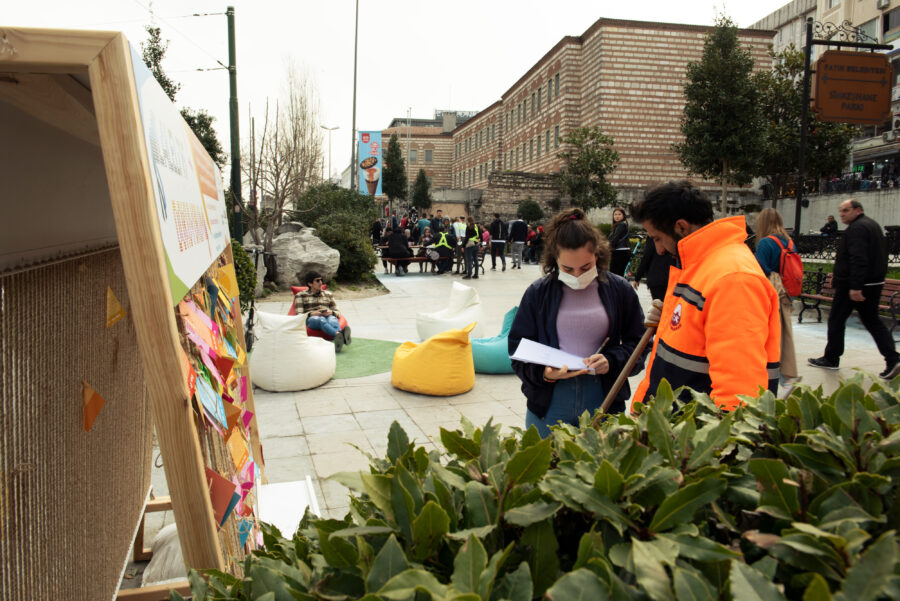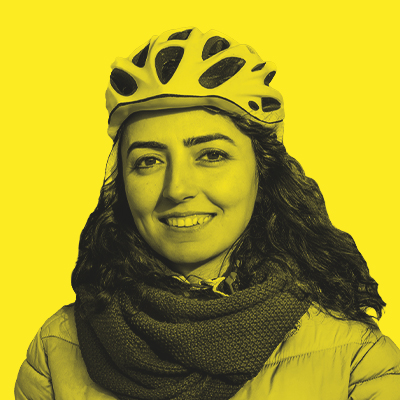6 min. read
Merve Akdag is an experienced architect and urban researcher working on integrating cultural awareness into interdisciplinary urban research, engagement projects, and development of spaces. She is currently working in the Transportation Department of Istanbul Metropolitan Municipality, and also initiates award winning socio-entrepreneurial projects.
–
Making changes to street design can take years, if it happens at all in times of increasing regulation, tension and administrative constraints. How can improvements be made more quickly?
We can assume that the transportation systems in cities are the capillaries in the body. While the process leading to the redesign of a street is determined by the corporate vision and master plans, the sustainability of the implementation is also formed by environmental participation. It is very important how the transportation vision of the city is determined in the process of change and transformation in urban areas. Ensuring that these visions and master plans are communicated with an inclusive approach has a catalytic effect in the
implementation process.
The Sustainable Urban Mobility Plan, which was completed last year by Istanbul Metropolitan Municipality, acts with such a vision. In this way, it also lays the groundwork for tactical practices such as Laleli Slow Down and Explore, which we did in the Historic Peninsula. While the mobility transformations in urban areas and the improvement process are progressing, the development of the governance capabilities of the institutions by developing the tools that will read the area correctly can facilitate the speed of construction and implementation in this direction.

Image: Istanbul Metropolitan Municipality
Your work makes use of awareness of cultural landscapes as part of urban space and mobility. Can you explain the reasoning and potential impact behind using culture as part of improving equitable urban mobility access and policy?
Istanbul is a city rich in urban and cultural landscape. The use of urban areas of communities with intense cultural diversity is determined in parallel with the possibilities of mobility. Awareness of urban users on this point creates a chance to improve fair mobility access and policies. The application of widespread and active mobility systems in urban areas also advances the process towards fair access in the city. In this context, we can say that the demands of the user communities in the field have become clear with the effect of the cultural situation.
An event that focuses on the culture of mobility creates a potential area of influence in proportion to its inclusiveness. The campaigns and announcements of the event arouse interest in people and increase participation. Urbanites are beginning to see themselves as involved in the urban space. It is possible to achieve a chain improvement in the city with this method, which is also related to the urban culture and belonging.
What is the importance of involving community organisations in a co-creational approach when building mobility solutions that are inclusive and locally relevant?
Although the final version of urban area decisions come from the municipalities, the primary determinant is how users adapt to the new mobility system by the level of urban resilience of the region and the sustainability of the decisions. Local communities and organisations are important actors in the establishment of the governance system, as they
can closely see the needs of the people in that region. In a crowded and cosmopolitan city like Istanbul, working with local teams is one of the prerequisites for efficiency in order to carry out authentic applications that need spaces.
What are some fast, small, low cost and transferable actions that you’ve experienced and would recommend to grassroots globally?
Spending the undefined time between planning, decision-making and implementation processes in urban areas with tactical applications makes it possible to interact with the area and the user in a wider legal framework. Workshops and field applications open a communication channel in the urban space, facilitating a healthier transfer of the application to the urban environment.
When people see this multiplying in different cities and countries, they feel more motivated towards a healthier urban life. Low-cost and within a certain time period applications provide testing and understanding users. In the name of mobility culture, short-term and effective campaigns are provided on the national and international scale. That’s why the proliferation of these applications in the form of a network in the world brings us to apply locally and wholly healthy designs.
You have worked for both a social enterprise and the government on improving public space. What would you recommend to each group (civil society and government) in order to improve collaboration around public space?
Although the dynamics of both groups are different from each other, they have certain complementary aspects. Ensuring cooperation in urban area development and improvement works as a common goal makes the difference for a healthy practice. When civil society creates active participation systems for institutions to develop their policies, when they interact with the public in the field, they also have a facilitating effect towards the common goal, as it develops a certain urban culture.
It is important for public institutions to further develop a collaborative working culture with the relevant users in the field for the establishment of the governance system. While open data systems develop within institutions, being sensitive to public access and interaction is an important step in an inclusive space management process. The field of architecture, design and urban studies seems to be advancing with studies in this direction. It can be an urban threshold for academies to touch urban life in a more practical sense and for institutions to use scientific studies as a resource.
Image: Istanbul Metropolitan Municipality

